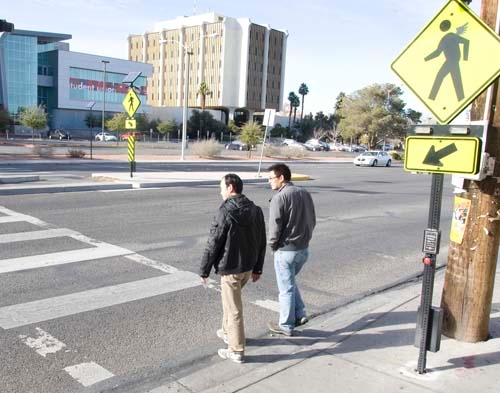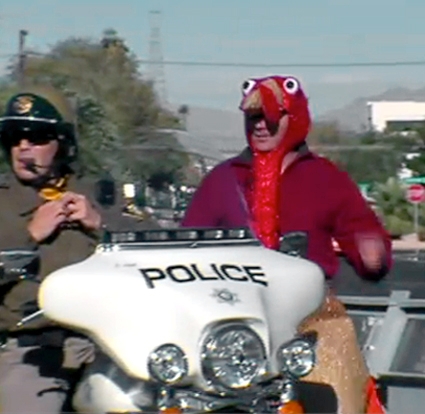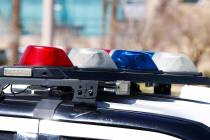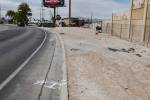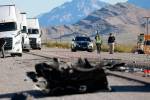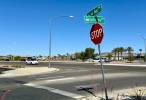Officials aim to improve pedestrian safety in Las Vegas
The shiny, 6-foot-tall turkey moves cautiously through the crosswalk. He bristles as a vehicle speeds by him, failing to yield.
The turkey signals to a nearby Las Vegas police motorcycle officer, who hits his lights and siren and pulls the vehicle over. A citation, resulting in a fine of $160 to $200, is issued.
It was a few days before Thanksgiving and police were using the turkey theme to raise awareness to an issue that's long given Las Vegas a black eye: pedestrian fatalities.
Officer Mike Lemley -- aka Officer ButterBall for the turkey-crossing-the-street exercise at Charleston Boulevard and Yew Avenue -- said the excuse is almost always the same: The driver didn't see him.
But if a motorist can't see a giant red turkey, replete with sequins, in the middle of the crosswalk, are they really looking for pedestrians at all?
"If they're not going to stop for me dressed up as a big, gold-and-orange turkey, they're not going to stop for a pedestrian dressed normally," Lemley said.
Erin Breen of the UNLV Safe Community Partnership, a traffic safety advocacy group, said Las Vegas culture needs to change.
"It's the climate, and I don't mean the air temperature," Breen said.
"It's just common courtesy. It galls me the most in the summertime when it's 130 degrees on the pavement. You're in your air-conditioned couch on wheels, and you can't do some poor schmo the common courtesy of stopping for him?"
Breen said it's no secret Las Vegas is a bad place to walk. The wide lanes and straight roads do little to curb speeders. In her 15 years on the job, Nevada has had the most pedestrian deaths per 100,000 population at least twice, and has been in the top five at least seven times.
Clark County accounts for 78 percent to 85 percent of the fatalities in Nevada every year, she said.
But the numbers have been steadily improving.
As of Thursday, there were 34 pedestrian fatalities in Clark County and 41 for the state in 2010.
That figure was up slightly from 2009, when Nevada was ranked the 19th-worst state, with 29 deaths in Clark County and 35 total in the state.
Those are some of the lowest pedestrian death tolls Nevada has seen in years, Breen said, and should keep the state out of the top 10 two years running.
Why the improved numbers?
"It's remarkable," Breen said. "It's a total group effort."
About five years ago, law enforcement agencies in Las Vegas created Joining Forces, a task force dedicated to improving traffic safety.
Using grant money, off-duty officers from Henderson, North Las Vegas, Las Vegas and the Nevada Highway Patrol target key areas of concern on the roads: seat belts, drunken driving, speeding and pedestrian safety.
Breen said the goal is not to have eight cops write 75 tickets at an intersection. The goal is for 100,000 people to see the news and ask, "Do I stop for pedestrians?"
"He (Lemley) was practically lit up like a Christmas tree, and they say they didn't see him," she said. "That's not a good excuse. It's your job as a driver to see someone in the crosswalk."
Maryland Parkway is a pedestrian trouble spot, as is downtown Las Vegas, Breen said.
The homeless and low-income families -- who can't afford to drive -- are often the victims simply because they travel more on foot.
"For the most part, these victims aren't the type of people who have a voice," she said.
In addition to increased enforcement, engineering improvements also have helped increase safety.
Installation of a new style of crosswalk, called a Danish offset, on Maryland Parkway near the University of Nevada, Las Vegas campus has dramatically reduced accidents at what was once a dangerous place to cross, she said.
The S-shaped Danish offset forces pedestrians to turn to the right when they reach a median between traffic lanes. Because pedestrians briefly face oncoming traffic, they can better see and avoid cars.
"It forces everyone to pay more attention," Breen said.
She said the Danish offset has been installed in several places in the city, including Lake Mead Boulevard just east of Civic Center Drive in North Las Vegas.
The Danish offset is not widely used because associated flashing lights and medians make them more expensive than a traditional crosswalk and because pedestrian safety takes a backseat to motorist convenience, Breen said.
"The ratio spent on saving pedestrian lives versus moving vehicles is clear," she said. "It's not a top priority."
Other tactics have been tested, some proving more effective than others.
In 2009, the Federal Highway Administration studied three cities with high pedestrian fatality rates: Las Vegas, Miami and San Francisco.
Pedestrian-activated flashing beacons, crossing signal buttons and the Danish offset proved effective in all three cities.
High-visibility crosswalks, yield signs and pedestrian zone signs were ineffective, indicating that drivers largely ignore signs.
Las Vegas weather conditions also are a factor. High temperature heats oil in the asphalt, which erodes crosswalk paint.
Breen said enforcement and improved engineering have driven down the death toll, but Lemley's not so sure.
Does enforcement make a difference?
"We would like to think so, but the truth is how you measure it," he said. "There's no real hard facts to measure how well education and enforcement does. They're just trends and they can go back up, and we won't know why."
Contact reporter Mike Blasky at mblasky@reviewjournal.com or 702-383-0283.
Las Vegas Metropolitan Police turkey crosswalk sting



